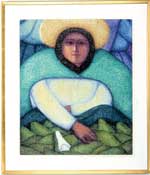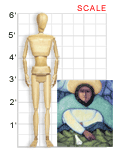VAM galleries including this work:
Jacobs Collection at Georgetown College | Go Figure || VAM Home
Ernesto Gutierrez (Peru, b. 1939)
LA FRUTERA, 1996
Oil on textured canvas; 32" X 37"
Collection of Dr. and Mrs. Donald Jacobs
The softness of La Frutera’s composition, created by smooth, rounded lines and a cool-toned palette, is offset by the vivacity of its colors and the strength of its shapes. Rendered with monumentality and confident lines, the woman is the focus of the painting. She peers out self-assuredly at the viewer as she thumbs through a pile of avocadoes. Visible behind her are what appear to be the bodies of two other women, both clad in cool blues.
Ernesto Gutierrez’s work pays homage to the ancient world of the Incas, interpreting that world into shapes, forms, and brilliant colors of the 21st century. The large faces he uses appear to be stoic and serene, like the proud ancient society they represent, but reveal an individual strength and personality.
In addition to the Pre-Columbian forms and Peruvian art of his homeland, Gutierrez has been influenced by modern French masters like Cézanne and Gauguin. He underlines and emphasizes the boldness of his palette—which includes shocking pinks, chartreuse, mauve hues, vibrant ochres, and the whole gamut of blues, purples, and greens—with blacks, maize, and pure white to enhance the drama of their effect. He clothes his personalities in costumes decorated in organic-looking forms, with the color placement reminiscent of designs used in Peruvian weavings. In many of his paintings, he assumes a Cubist/Realist simplification of forms and volumes and a precise rendering of surfaces. He applies paint to the canvas in parallel brushstrokes that are expressionistic in nature.
About the Artist
Ernesto Gutierrez was born in Lima, Peru, in 1941. His father was a Spaniard and his mother a descendant of the Incas. After completing high school, Gutierrez entered Lima’s School of Fine Arts, where he received a Bachelor of Fine Arts in 1964. He was granted the Itamarti Scholarship in 1966, which allowed him to study for two years at the Museum of Modern Art in Rio de Janeiro while at the same time exhibiting his work throughout the art centers of South America. In 1972, Gutierrez was awarded a Fulbright Scholarship. He also studied at the University of Wisconsin, earning his Master of Fine Arts there in 1976. His work is evocative and reflects Peruvian landscapes and folklore as well as his Incan heritage.
Classroom Ideas
Discussion: From what part of the world do you think this woman originates? What makes you think so? Does this painting have a warm or cool feel to it? What in the painting makes you feel this way?
Activity: Gutierrez’s work is influenced by his heritage. Think about your own heritage. Did your family emigrate from another country? Do you identify with a particular culture or ethnic group? Is there someone in your family who embodies your heritage? Paint a portrait of this person in Gutierrez’s style. Make sure to include details, colors, or shapes that reflect this person’s heritage.
Links
Visit the Jacobs Collection at Georgetown College to view Rosita, another painting by Ernesto Gutierrez.
[spider.georgetowncollege.edu/art/artdept_04/pages/Jacobs/]
See more of Gutierrez’s work at the Madelyn Jordon Fine Art Gallery.
[www.madelynjordonfineart.com/artists/artist_ins.php3?artist=7]
Artist’s Madonna Voices Longing is a brief article from the Milwaukee Journal Sentinel about Gutierrez’s representation of mother figures in his art.
[www.jsonline.com/onwisconsin/arts/sep03/170608.asp]
Gutierrez’s influences include his Incan heritage as well as the landscape and culture of Peru. Here are some sites where you can explore that background:
- The Incas from El Centro Cultural Perú
[incas.perucultural.org.pe/english/] - Ancient Peruvian Textiles from Cultural Expeditions
[www.culturalexpeditions.com/history_peru_textiles.html] - Virtual tour of Machu Picchu
[www.raingod.com/angus/Gallery/Photos/SouthAmerica/Peru/IncaTrail.html]

